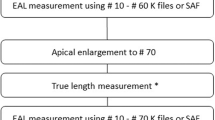Abstract
Purpose
Electronic foramen locators are widely used to locate the apical foramen (AF), by measuring the electrical impedance between the electrodes (Z E). There is no in vivo study that completely characterizes Z E as a function of frequency and endodontic file tip position. The results of in vivo studies of the impedance Z E and a coefficient that can be used to locate the AF are presented.
Methods
An electronic device was specially built to study Z E . Ten root canals were used in the experiment. The spectral attenuation of Z E was in vivo measured with the endodontic file tip placed at −3.0, −2.5, −2.0, −1.5, −1.0, −0.5 and zero millimeters from the root canal AF. At each file position the spectrum attenuation was modeled. Based on the attenuation models an endodontic spectral attenuation coefficient (ESAC) was defined.
Results
The in vivo results demonstrate that the spectral attenuation of the electrical impedance Z E has an exponential decay in the frequency range of the study. It was verified that ESAC can be correlated to the distance between the endodontic file tip and the apical foramen. The ESAC accuracy was assessed and the results showed that it can locate the AF with accuracy better than 0.5mm.
Conclusions
The spectral attenuation of Z E has an exponential decay for all file tip distances from the AF. It supports the feasibility of ESAC to accurately locate the root canal AF. Moreover, using frequencies steps of one octave makes the implementation of ESAC in an embedded system easier.
Similar content being viewed by others
References
ElAyouti A, Weiger R, Löst C. The ability of Root ZX apex locator to reduce the frequency of overestimated radiographic working length. J Endod. 2002; 28(2):116–119.
Jenkins JA, Walker WA, Schindler WG, Flores CM. An in vitro evaluation of the accuracy of the Root ZX in the presence of various irrigants. J Endod. 2001; 27(3):209–211.
Katz A, Tamse A, Kaufman AY. Tooth length determination: a review. Oral Surg Oral Med Oral Pathol. 1991; 72(2):238–242.
Leonardo MR, Silva LA, Nelson-Filho P, Silva RA, Raffaini MS. Ex vivo evaluation of the accuracy of two electronic apex locators during root canal length determination in primary teeth. Int Endod J. 2008; 41(4):317–321.
Shabahang S, Goon WW, Gluskin AH. An in vivo evaluation of Root ZX electronic apex locator. J Endod. 1996; 22(11):616–618.
Welk AR, Baumgartner JC, Marshall JG. An in vivo comparison of two frequency-based electronic apex locators. J Endod. 2003; 29(8):497–500.
Al-bulushi A, Levinkind M, Flanagan M, Ng Y-L, Gulabivala K. Effect of canal preparation and residual root filling material on root impedance. Int Endod J. 2008; 41(10):892–904.
Ardeshna SM, Flanagan M, Ng Y-L, Gulabivala K. An ex vivo investigation of the relationship between apical root impedance and canal anatomy. Int Endod J. 2011; 44(6):525–533.
Krizaj D, Jan J, Valencic V. Numerical computation of impedances of a human tooth for estimation of the root canal length. IEEE T Bio-med Eng. 2002; 49(7):746–748.
Levinkind M. A dental application of neural network computing: classification of complex electrical impedance measurements to aid root canal treatment. Neural Comput Appl. 1994; 2(4):209–215.
Meredith N, Gulabivala K. Electrical impedance measurements of root canal length. Endod Dent Traumatol. 1997; 13(3):126–131.
Pilot TF, Pitts DL. Determination of impedance changes at varying frequencies in relation to root canal file position and irrigant. J Endod. 1997; 23(12):719–724.
Sunada I. New method for measuring the length of root canal. J Dent Res. 1962; 41(12):719–724.
Gordon MP, Chandler NP. Electronic apex locators. Int Endod J. 2004; 37(7):425–437.
Kobayashi C. Electronic canal length measurement. Oral Surg Oral Med Oral Pathol Oral Radiol Endod. 1995; 79(2):226–231.
Kobayashi C, Suda H. New electronic canal measuring device based on the ratio method. J Endod. 1994; 20(3):111–114.
Masreliez CJ. Method and apparatus for apical detection with complex impedance measurement, US Patent n. 5759159. 1998.
Bernardes RA, Duarte MAH, Vasconcelos BC, Moraes IG, Bernardineli N, Garcia RB, Baldi JV, Victorino FR, Bramante CM. Evaluation of precision of length determination with 3 electronic apex locators: Root ZX, Elements Diagnostic Unit and Apex Locator, and RomiAPEX D-30. Oral Surg Oral Med Oral Pathol Oral Radiol Endod. 2007; 104(4):e91–e94.
Rambo MVH, Gamba HR, Borba GB, Maia JM, Ramos CA. In vivo assessment of the impedance ratio method used in electronic foramen locators. Biomed Eng Online 2010; 9(46): doi:10.1186/1475-925X-9-46
Krizaj D, Jan J, Valencic V. Modeling AC current conduction through a human tooth. Bioelectromagnetics. 2004; 25(3):185–195.
Kim E, Marmo M, Lee CY, Oh NS, Kim IK. An in vivo comparison of working length determination by only root-ZX apex locator versus combining root-ZX apex locator with radiographs using a new impression technique. Oral Surg Oral Med O. 2008; 105(4):e79–e83.
Jan J, Krizaj D. Accuracy of root canal length determination with the impedance ratio method. Int Endod J. 2009; 42(9):819–826.
Huang L. An experimental study of the principle of electronic root canal measurement. J Endod. 1987; 13(2):60–64.
Mirtaheri P, Grimnes S, Martinsen OG. Electrode polarization impedance in weak NaCl aqueous solutions. IEEE T Bio-med Eng. 2005; 52(12):2093–2099.
Pethig R. Dielectric properties of body tissues. Clin Phys Physiol Meas. 1987; 8(Suppl. A): 5–12.
Webster JG. Electrical impedance tomography. Bristol: Adam Hilger; 1990.
Author information
Authors and Affiliations
Corresponding author
Rights and permissions
About this article
Cite this article
Gamba, H.R., Rambo, M.V.H., Borba, G.B. et al. In vivo characterization of the electrical impedance between the electrodes of the electronic foramen locators. Biomed. Eng. Lett. 3, 170–178 (2013). https://doi.org/10.1007/s13534-013-0100-4
Received:
Revised:
Accepted:
Published:
Issue Date:
DOI: https://doi.org/10.1007/s13534-013-0100-4




